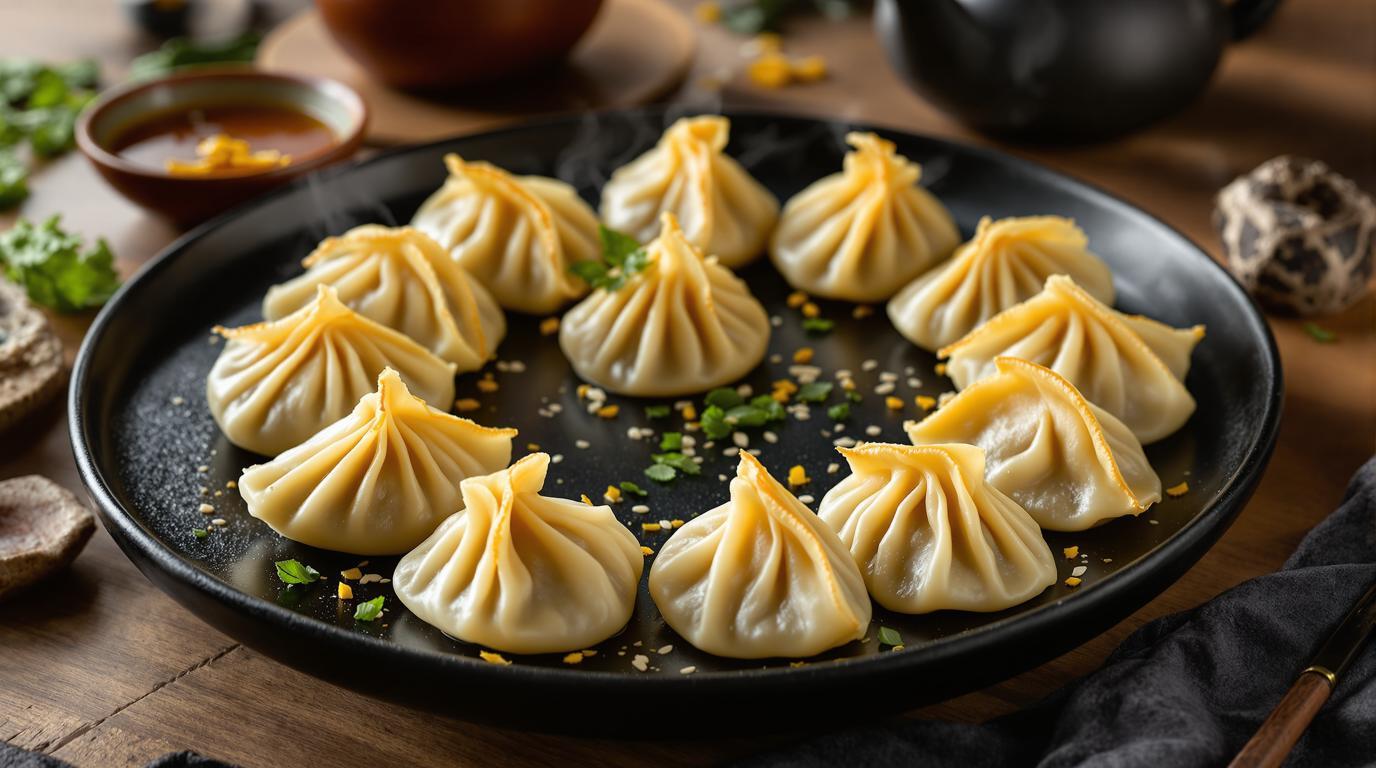The first time I ever made gyoza at home, I expected the usual anxiety that comes with trying a new culinary technique. Instead, I found myself in a meditative rhythm: fold, pleat, seal, repeat. There’s something deeply satisfying about transforming a simple circle of dough into these crescent-shaped dumplings that crisp up gloriously on one side while remaining delicately tender on the other. These Japanese dumplings aren’t just food—they’re a perfect marriage of texture and technique that will transport you straight to an izakaya in Tokyo, with a modern ponzu sauce that adds bright, complex notes to each bite.
The Story
Gyoza arrived in Japan from China after World War II, when soldiers returned home with a taste for Chinese jiaozi dumplings. The Japanese version evolved to feature thinner wrappers and a distinctive cooking method—the magical “fry-steam-fry” technique that creates that signature crispy bottom while keeping the top tender. In my travels through Japan, I discovered regional variations that fascinated me: Tokyo’s Kanto-style features delicate wrappers with slightly sweet fillings, while Osaka’s Kansai-style boasts thicker skins and heartier fillings. The recipe I’m sharing combines traditional technique with a modern, vibrant ponzu sauce that elevates these humble dumplings to restaurant-quality status.
Ingredients Spotlight
For the gyoza (makes about 24):
- 1 package gyoza wrappers (or wonton wrappers in a pinch)
- 8 oz (225g) ground pork (not too lean—you want some fat for juiciness)
- 4 oz (115g) napa cabbage, finely chopped
- 2 green onions, finely chopped
- 2 cloves garlic, microplaned
- 1 teaspoon fresh ginger, microplaned
- 1 tablespoon soy sauce
- 1 teaspoon sesame oil
- ½ teaspoon white pepper
- ¼ teaspoon salt
- 2 tablespoons neutral oil for frying
- ¼ cup water for steaming
For the modern ponzu sauce:
- 3 tablespoons rice vinegar
- 2 tablespoons soy sauce
- 1 tablespoon mirin
- 1 teaspoon yuzu juice (or lemon + lime juice if unavailable)
- ½ teaspoon grated citrus zest
- 1 small garlic clove, microplaned
- 1 teaspoon toasted sesame oil
- Pinch of red pepper flakes
Step-by-Step Guide
1. Prep the cabbage: Sprinkle chopped cabbage with ½ teaspoon salt and let sit for 10 minutes. Squeeze out excess moisture with your hands or in a clean kitchen towel—this prevents soggy gyoza.
2. Mix the filling: Combine ground pork, cabbage, green onions, garlic, ginger, soy sauce, sesame oil, and white pepper in a bowl. Mix thoroughly with your hands until slightly sticky, about 2 minutes. The mixture should hold together when squeezed.
3. Form the gyoza: Place a teaspoon of filling in the center of each wrapper. Moisten the edge with water using your fingertip. Fold the wrapper in half, then create 4-5 pleats along the edge, pressing firmly to seal. The gyoza should sit flat with the pleated side up.
4. Master the fry-steam-fry: Heat oil in a non-stick skillet over medium-high heat (about 350°F/175°C). Arrange gyoza in a circular pattern, flat side down. Cook until golden brown on the bottom, about 2-3 minutes. Pour in water (it will sizzle dramatically), immediately cover with a lid, and reduce heat to medium. Steam for 3-4 minutes until the water evaporates and the wrappers become translucent.
5. Crisp finale: Remove the lid and increase heat slightly. Cook for another minute until the bottoms re-crisp. Transfer to a plate, crispy side up.
6. Craft the ponzu: Whisk together all ponzu ingredients in a small bowl. Let sit for 5 minutes to allow flavors to meld.
Expert Techniques
The most common gyoza pitfall is overstuffing. A scant teaspoon of filling is all you need—the wrapper should fold easily without straining. When pleating, think of it as creating tiny fans with your fingertips. Each pleat should overlap the previous one slightly, working your way around the edge.
Chef’s Note: The pleating might seem intimidating, but don’t overthink it. My first batch looked like crumpled paper bags, but they still tasted incredible. What matters most is a tight seal to keep the juices inside during cooking. If you’re struggling, simply fold them in half for a half-moon shape and press firmly—function over form!
The magical “crispy skirt” that professional chefs create comes from a quick slurry of 1 teaspoon flour mixed into your steaming water. As it evaporates, it creates a delicate, lacy connecting crisp between the dumplings.
Presentation & Pairing Ideas
Serve gyoza crispy-side up on a warmed plate, arranged in a circular pattern that showcases their golden bottoms. Place the ponzu sauce in a small dipping bowl alongside rather than pouring it over, which would soften that precious crisp texture. For a complete meal, pair with a simple miso soup and quick-pickled cucumbers dressed with rice vinegar and sesame seeds.
For a fusion approach, try using gyoza as a topping for ramen or serving them alongside a crisp Asian-inspired salad. For beverage pairings, Japanese beer is traditional, but I’ve found a crisp Grüner Veltliner or even a dry hard cider works beautifully with the savory-bright flavor profile.
Gyoza freeze beautifully before cooking—arrange them on a parchment-lined tray, freeze until solid, then transfer to a freezer bag. Cook them straight from frozen, just add an extra minute of steaming time. This means you can make a big batch on a weekend and have homemade gyoza ready in minutes, perfect for transforming an ordinary weeknight into something special—or creating an impressive dinner party appetizer with minimal day-of effort. Let these little crescents of joy be your gateway to Japanese cooking at home, and don’t be afraid to make them your own with different fillings like chicken, shrimp, or mushrooms for a vegetarian option. The technique, once mastered, opens a world of dumpling possibilities. 🥟
